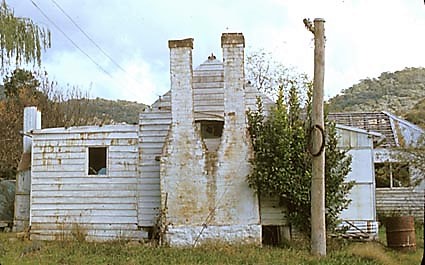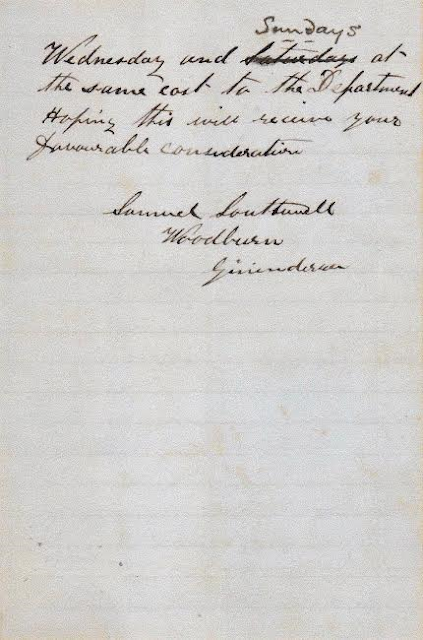Introduction, Brief History & Acknowledgments

Canberra NSW Type 1A date stamp 25 August 1864 on 1d NSW joined pair. Earliest recorded use, pre dating Hopson & Tobin by 11 years. Ex Hugh Freeman.
For a relatively young city, it is not surprising, even among the residents of Canberra, how little is known of its history. For some, not familiar with the history, Canberra's beginnings were in 1927, when the Federal legislature moved there from Melbourne, whilst others think of the year 1913, when the city was officially named as the Federal Capital of Australia. However, our Capital's origins are much earlier, as are those of the postal services which provided integral communications to a growing community, from around the middle of the 19th Century.
With few exceptions, a large number of the postmarks of Canberra and the region are decidedly scarce, with several in the rare to very rare category. Up until the emergence in the nineteen eighties of the De Salis correspondence, examples of pre 1913 material were few and far between. Even to this date, Bulga Creek, numeral cancellation '1497', which preceded Yarralumla (I) and later Cotter Junction post offices, remains NNR - (Number not reported) and Tuggranong, numeral cancellation '1299' is rated RRRRR - (Only 1 - 2 copies known). Later circular date stamps such as Russell Hill, are rarely seen and missing from many significant collections.
December 8 1870 cover from Sydney to Duntroon, near Canberry via Queanbeyan. A rare item of local postal history. |
Many of the region's post offices were small by general standards, servicing comparatively few community members, hence it likely in some cases, that any items of mail to have survived, would be in very small numbers. Thus for the potential postmark collector there is sufficient incentive to inspire, generate and maintain interest as the hunt for elusive items goes on.
Australian Capital Territory
A very early postcard depicting the site of Canberra - Howard & Shearsby. Yass |
Early history
Dr. Charles Throsby, a ship’s surgeon who had arrived in Sydney in 1802, and was a pioneer settler in the Moss Vale district of New South Wales, was the first European to set foot in what is now the A.C.T. , in October 1820. Noting the geological character of the area, he named it the Limestone Plains.
Lt. Joshua Moore and Robert Campbell were the first two landholders on the Limestone Plains. From 1823, employees of Joshua Moore pastured sheep and cattle on his property, on which site the suburb of Acton now stands. Lt. Arthur Jeffreys, R.N. , acquired the property from Joshua Moore in 1843, and named it Acton after his home town in Wales.
Robert Campbell was granted land and a quantity of livestock as compensation for the loss of a ship he had owned which had been chartered by the Government to bring much needed food to Sydney. The ship was wrecked off the coast of New Guinea. James Ainslie, overseer for Campbell, settled at Duntroon about the end of 1825.
 |
An early postcard depicting Duntroon Homestead in 1910 – Howard & Shearsby. Yass |
Establishment
Federation of the Australian states was achieved in 1901, when the Constitution of that year imposed on the Commonwealth Parliament the duty of creating a National Capital.
The site of the new capital, approximately 150 miles south west of Sydney, was not finally settled upon until 1908. A world-wide competition held in 1911 for a design for the National Capital was won by an American architect, Walter Burley Griffin.
Effective on 1st January 1911, an area of some 900 square miles was transferred by New South Wales to become Federal Capital Territory, which included 2 square miles of land at Jervis Bay on the NSW coast, 80 miles south of Sydney. This was increased to an area of 28 square miles in 1915.
The foundation stone for the new capital was laid on 12 March 1913, and named Canberra by Lady Denman, wife of the Governor-General. The site of the ceremony looked out over an empty and almost treeless valley. World War 1 intervened and there were further delays until in 1924 the plan of Walter Burley Griffin became the statutory plan for the layout of the city.
Early postcard depicting the official ceremony for the naming of Canberra as the Federal Capital – Howard & Shearsby. Yass |
The Federal Capital Territory became the Australian Capital Territory, by statute, in 1938.
The Post Office
The first post office in what is now the A.C.T was opened on the 1st April 1859, at Ginninderra, on the present Barton Highway, 8 miles north of Canberra. This was followed by Lanyon, in 1860 in the hamlet of Tharwa, and then three years later at Canberra. Progressively, as the community grew, so did the number and location of post offices in the region.
Post offices, which had previously been part of New South Wales, had their date-stamps, used for cancelling articles of mail, changed from N.S.W. to F.C.T and later A.C.T. In the case of the Molonglo Settlement, an interim date stamp was inscribed C.C.T (Commonwealth Capital Territory) and in the case of Jervis Bay, Federal Territory. Others were simply inscribed with the place name and Australia, without reference to the State or Territory.
 |
14 May 1857 mourning cover addressed to Mrs Smith, Canberra Parsonage, Queanbeyan. Dumb obliterator together with Type 1A Sydney A date stamp cancelling imperforate 2d blue. Type O(ii) Morpeth backstamp. Mrs Smith was wife of Reverend Pierce Galliard Smith appointed Rector of Saint Johns Church at Canberra in 1855. Cover pre-dates postal facilities in the region other than Queanbeyan. De Salis correspondence Ex Alan Salisbury. |
Object of this blog
As a collector of New South Wales postmarks and a resident of the Australian Capital Territory for over fifty years, the postal history of the Territory has always held a special place in terms of my philatelic interests and priorities. Whilst for a time I collected Australian stamps, first day covers etc. as many collectors do, my interest began to wane as the number and frequency of new issues began to rapidly multiply and the boom/bust investment environment of the nineteen eighties adversely impacted the value of average material. It was not too long before my interest turned to the reason that stamps were issued, their use and the unique cancellations applied to mail by individual post offices. The change in direction enabled me to combine my hobby with a secondary interest in local history.
To date, no specific publication, dealing exclusively with the postmarks of Canberra and the Australian Capital Territory, has been forthcoming. Available information is to be derived from the substantial work of distinguished philatelists Norm Hopson and Bob Tobin, contained in their four volume monograph "N.S.W. and A.C.T. POST, RECEIVING, TELEGRAPH & TELEPHONE OFFICES", published in 1991, R.C.M Dale's, "Postal History of the Australian Capital Territory" published in 1958 and Hugh Freeman's "The Numeral Cancellations of New South Wales" published in 2012. All serve as valuable guides to those with an interest in the postal history and postmarks of the region.
However, for those just starting out, I thought it might be useful to attempt, through this blog, to consolidate and display relevant information and images of items contained in my own collection, in a simple and concise form, hopefully value adding to the existing knowledge base on the subject, as well as encouraging interest from newcomers to an area of collecting that is both rewarding and challenging, yet manageable in terms of breadth and number of offices and the various cancellations, as well as the potential financial outlay in terms of acquiring new material and building a reasonable collection.
Postman delivering mail in Canberra by bicycle in 1961 (NAA). |
Acknowledgments
In addition to those mentioned above I would also like to acknowledge the previous contributions made on this subject, during their lifetimes, by two former residents of Canberra and distinguished philatelists in their own right, the late Alan Salisbury and Dr Ed Druce, who formed significant collections of local material, as did the late Alex Gavin.
I also wish to acknowledge and thank Gary Watson and David Wood, together with the late Hugh Freeman and Rod Perry, who periodically over the years assisted me in filling a few gaps and dealing with the occasional query. In the case of the first two that relationship continues. Their assistance is gratefully acknowledged and always much appreciated.
Further, I wish to acknowledge the National Archives of Australia, custodians of the official post office files, from where a significant amount of the information contained in this blog is derived. There is no better source of information then the original source and the National Archives are truly national treasures. There is not a single instance where I have examined a post office file and not learned something I didn't know previously.
More recently I have been provided with assistance by Mr Richard Breckon, Team Leader Philatelic Archives, Philatelic Group, Australia Post, who facilitated me with access to Alan Salisbury's A.C.T. date stamp collection, acquired by the Archives in 2000. Alan's network of contacts across the local postal network ensured that his knowledge of openings, closings, use of date stamps (including reliefs) and registration labels was second to none.
Finally, I want to acknowledge my late father, Kevin Curtis, who passed away in 2005, and to whom I dedicate this blog. In the early days of his career dad served as Postmaster, Canberra City Post Office, before moving on to a distinguished public service career culminating in his appointment as Secretary and Manager of the then National Capital Development Commission, from where he retired in 1983. Whilst his philatelic interests generally differed to mine, he none the less was a wealth of information when it came to knowledge of the post office and Canberra's development. His contribution to the Australian Capital Territory was recognised with a street being named after him in the newly developed Canberra suburb of Casey, following his passing.
Additional information
To access a particular post office name or numeral cancellation number in the Blog, please left click with your mouse on the respective number or name label from the drop down list at the top of the page. This will take you to all posts where that name or number has been referenced.
Images contained in this blog are of items contained in my personal collection and are not for sale. I welcome queries and contributions from anyone with an interest in the subject. I am able to be contacted at curtistony1953@gmail.com
Note: This blog is a work in progress with a great deal more information and images to be added as time permits. I hope that you find it of interest.















